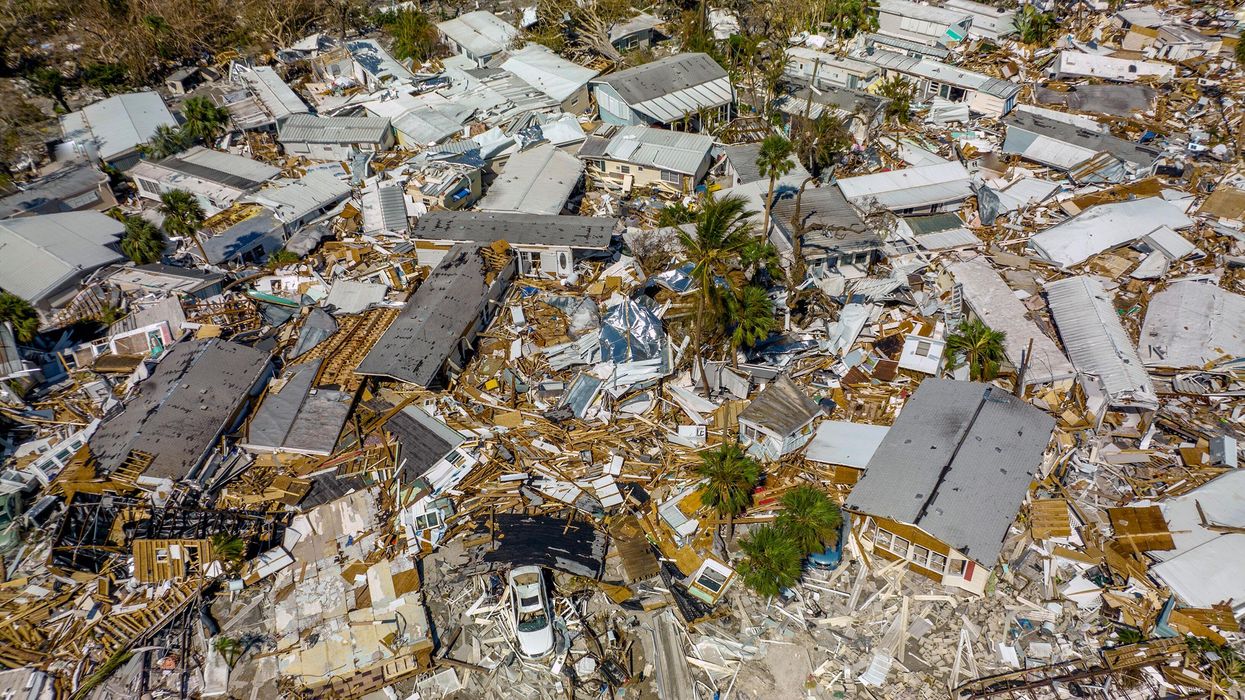(CNN) — The United States was lashed by 18 catastrophic extreme weather and climate disasters costing at least $1 billion each last year, a new report shows. They came in the form of tornadoes, extreme heat and cold, deadly flooding and hurricanes, and a climate change-fueled drought in the West.
When taken together, the country's so-called billion-dollar disasters inflicted at least $165 billion in damage last year — surpassing 2021 disasters in cost — and caused at least 474 deaths, according to the report from the National Oceanic and Atmospheric Administration.
Hurricane Ian, the Category 4 storm that left a trail of devastation across the Caribbean and Florida, carried the highest economic toll of nearly $113 billion, along with a death toll of 152, NOAA reported.
The second-costliest disaster was a blistering summer heat wave and the historic drought, which spread from the West to the Mississippi River, totaling about $22.2 billion in damages.
Over the last seven years, 122 separate billion-dollar disasters have killed at least 5,000 people and cost the US more than $1 trillion in damages, the agency said.
At the annual meeting of the American Meteorological Society this week, where NOAA officials will present their findings, scientists say the fingerprints of climate change are all over these extreme weather disasters.
"What we've learned over the past 20 years is that extreme events are the face of climate change," Stephanie Herring, climate scientist at the NOAA National Centers for Environmental Information, told journalists on Monday.
People may not notice a small change in global average temperature, Herring said, but those changes "have huge impacts" on the frequency and intensity of extreme weather events.
Five of the last six years, except 2019, have seen disasters exceed the $100-billion mark, a signal that extreme weather events are becoming more costly and destructive as climate change accelerates.
"We're talking big money here and it's consistent," Adam Smith, applied climatologist with NOAA who led the report, told CNN. "This is another trend where the cost and the impacts are quite large and so we need to think about how to better mitigate future damages because we know these extremes will continue to happen."
Last year's financial toll was third-highest on record so far, behind 2020 and 2021. But Smith noted the total cost could rise several billion dollars once NOAA accounts for the damages of the late-December blizzard and cold snap.
"We're still calculating the cost of that event, which was so late in the year, but it's clearly a several billion-dollar event and will actually add to the total we already have of $165 billion," Smith said. "So the total of 2022 will actually exceed $165 once we add the Christmas, winter storm impacts on top of that number."
Last year closed with a series of disastrous storms in the West, and California is still being hammered by torrential rain, causing destructive flooding. Scientists have found climate change is not just increasing the severity of extreme weather, it is interrupting the usual patterns and causing wild swings between dry and wet extremes. In California, the multiyear drought has dried out the land so intensely, it is less able to absorb heavy rainfall, making flooding more likely.
Smith underscored a few main factors contributing to the growing economic toll, including how people continue to move into harm's way and the increased vulnerability given where and how structures are built.
And then there's the climate crisis: "Climate change is intensifying many of these extremes that lead to billion-dollar disasters," Smith said.
President Joe Biden in August signed the Democrats' Inflation Reduction Act, which contains $370 billion for climate and clean energy tax credits and new programs. Analysts and estimates from the lawmakers show the law would significantly cut planet-warming emissions, which scientists say would ultimately lead to fewer and less-extreme climate disasters.
The funding, which is designed to be applied over the course of 10 years, pales in comparison to what the US is now spending each year on disasters.
"Time is of the essence," Smith said. "Because all of these extremes, impacts, disasters, and fatalities have happened, there's so many different lessons across many parts of the country, for many different disaster types and many different populations that we can start to implement. And sooner is certainly better."
NOAA's annual report only captures the costliest disasters and serves as a snapshot to quantify the toll of extreme weather and climate change across the US. Globally, extreme weather events in 2022 cost roughly $270 billion, new data from reinsurance company Munich Re shows. Hurricane Ian was the costliest disaster in Munich Re's report, followed by the deadly flooding in Pakistan.
An extreme weather event or climate disaster occurred every day, on average, somewhere in the world over the last 50 years, the World Meteorological Organization reported in 2021, and the frequency of such events increased by a factor of five over the same period.
Around the world, the economic toll of the disasters has climbed sevenfold since the 1970s, the UN agency found.
The 18 billion-dollar disasters of 2022
Hurricane Ian, September 28-30: $112.9 billion
Western/Central drought and heat wave, 2022: $22.2 billion
Central US derecho, June 13: $ $3.2 billion
Western wildfires, spring and fall: $3.1 billion
North Central severe weather, May 11-12: $2.8 billion
Southern severe weather, April 11-13: $2.8 billion
Hurricane Fiona, September 17-18: $2.5 billion
North Central hail storms, May 19: $2.5 billion
North Central hail storms, May 9: $2.2 billion
Central severe weather, June 7-8: $1.9 billion
Kentucky and Missouri Flooding, July 26-28: $1.5 billion
Southeastern tornado outbreak, April 4-6: $1.5 billion
Southern tornado outbreak, March 30: $1.3 billion
North Central and Eastern severe weather, July 22-24: $1.3 billion
Southern and Central severe weather, May 1-3: $1.2 billion
Hurricane Nicole, November 10-11: $1 billion
Texas hail storms, February 21-22: $1 billion
Central and Eastern winter storm and cold wave, December 21-26: To be determined
The-CNN-Wire
™ & © 2023 Cable News Network, Inc., a Warner Bros. Discovery Company. All rights reserved.
- National Weather Service Warns California as Bomb Cyclone Approaches ›
- Wealthy Nations Create Fund for Climate Change Damages ›
- More Americans Are Moving Into Harm's Way as Climate Disasters Increase ›
- Climate Advocacy Group Vows to Stop Disruptive Protests ›
- Climate Change Disproportionately Impacts Latino Communities ›
- How Climate Change Leaves Women at Risk of Domestic Violence ›
- Alabama Tornadoes Leave Six Dead After Devastating Southeast Storms - Advocate Channel ›
- Oceans Warm to Record Temperatures, Impacting Extreme Weather ›


















































